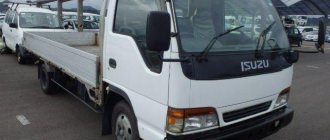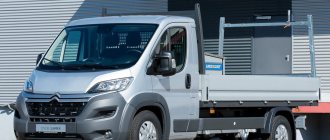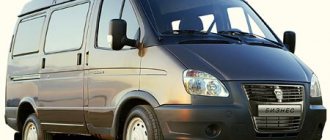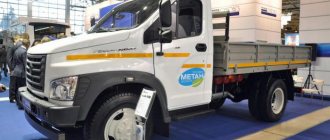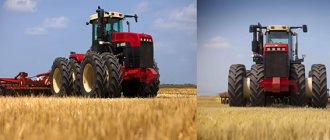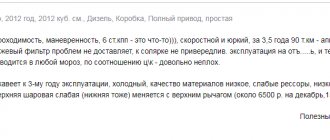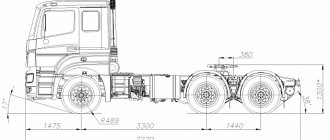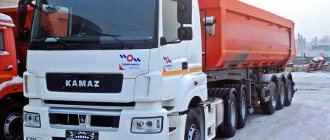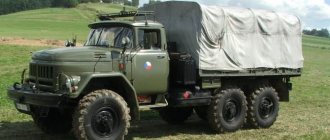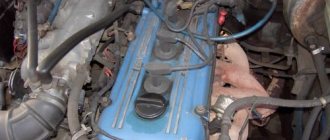Isuzu Motors Ltd is the first car company in Japan. It was founded in 1916. At the moment, this company is one of the largest in the production of trucks and off-road vehicles. The Isuzu truck has earned the right to such popularity thanks to its very diverse models, excellent price/quality ratio and very low-cost maintenance.
The Isuzu company began cooperating with the USSR back in 1969. And in 2006, the first isuzu tractor in Russia was produced at the Ulyanovsk Automobile Plant.
Isuzu models can be divided into two groups: commercial trucks and private cars. Isuzu commercial trucks are also usually divided into two subgroups: buses and trucks. Isuzu trucks have a wide variety, especially when it comes to payload and gross weight (from 3 to 33 tons).
Series N
The model range is divided into 3 series:
- N – representatives of this series transport cargo up to 5.5 tons (among the modifications there are vehicles for various purposes: refrigerators, vans, etc.);
- C\F – lifting capacity up to 20 tons (truck cranes, vehicles for transporting bulk materials, concrete mixers, etc.);
- E – vehicle for heavy loads and difficult working conditions.
Compact Japanese trucks Isuzu Elf
Japanese cars have taken a strong place in the Russian market since the mid-90s. Not only passenger cars are in constant demand, but also medium-duty trucks, which are actively used in small businesses. The Japanese company Isuzu Motors Ltd, in close cooperation with Russian companies, produces perhaps the most popular model series, Isuzu NQR, which includes the Isuzu NQR 75.
The Isuzu NQR 75 chassis, in terms of its technical characteristics, is an ideal car for Russian conditions, which has been repeatedly confirmed by customer reviews. The car with a wheelbase of 3815 mm is equipped with a turbocharged diesel engine with a capacity of 150 l/hp (Euro 3 environmental safety standard), with a volume of 5193 cm3 and intercooling of the charge air.
The engine life of all models is calculated at 1,000,000 km. The car is equipped with a 100 liter fuel tank, the manufacturer claims a fuel consumption of 17 liters/100 km. According to driver reviews, a car when fully loaded (especially in winter) consumes from 15 to 20 liters.
A load capacity of 5000 kg allows the installation of various onboard superstructures, manipulators and vans on this Isuzu NQR 75 model. But you should not overload the machine, which has a fairly strong riveted frame. The car can be used in urban environments and for transporting goods between settlements. The compact dimensions of the truck (length 6610 mm, width 1995 mm) and small turning angle (7.6 and 8.5 meters for different models) allow loading and unloading and moving in dense city traffic.
It is known that automakers are big dreamers when it comes to names for their cars. But if Nissan and Mazda christened their light-duty trucks with the sonorous names of Greek mythological heroes who were distinguished by great strength - Atlas and Titan, respectively, then the most popular truck from Isuzu, in comparison with them, received a more modest name, but more accurately reflecting its essence: small - but remote. At the same time, he still managed to beat his competitors on all counts.Current problems
The Isuzu Elf is generally considered a very reliable and unpretentious car, however, like any other car, it has some characteristic features that can lead to serious trouble. And all of them are usually associated with the peculiarities of Russian exploitation.
The weakest point of the Isuzu Elf, and many other trucks with a similar cabin layout, is traditionally considered to be the air filter. It is located very low, in the wheel well under the cab (on some modifications it is placed behind the front wheel under the body), and besides, the body is plastic; getting a crack after being hit by a flying stone is a common occurrence.
Experienced “elfists” and other specialists in trucks, to solve the problem at its root, immediately after purchase recommend moving the air filter to a safer place. Sometimes “KAMAZ” spare parts are used for this, and the filter and air intake pipe are installed behind the cabin and as high as possible. If you don’t want to do any modifications, you definitely need to come up with some kind of protection, say, install an additional casing that protects the plastic case from damage. If dirt or dust enters the air ducts past the filter element, it will most likely end in premature and catastrophic wear of the diesel engine. And this will happen quite quickly.
Another problem - diesel fuel purification - is being radically solved in the same way. For diesel engines, there are two types of filters - fine and coarse. A fine filter is a filter element combined with a mechanical pump (for manual pumping of fuel). The coarse filter (placed immediately after the tank) is simply a sump from which accumulated water must be periodically removed and the fuel inlet mesh must be cleaned. Apparently the quality of Japanese diesel fuel is so high that manufacturers often do not install coarse filters on diesel cars, this is especially typical for cars produced since the mid-90s. If there is no such filter on the Elf, it makes sense to install it. It won’t be superfluous - the benefits are undeniable, and its resistance is practically zero (unless, of course, the mesh is clogged with various rubbish - you just need to clean it regularly). A kit from a KAMAZ truck or tractor is also suitable for this.
Separ filter. You can install this kit yourself
| Electronic fuel equipment is the most expensive option to repair |
To extend the life of the standard fine filter, you can pair it with an additional one.
True, when installing additional filters, experts put forward a strict mandatory condition - that there should be no air leaks, otherwise problems will begin with starting, with fuel consumption, and it is possible that the engine will stop starting. It doesn’t cost an experienced self-taught person anything to build a mount for replaceable KAMAZ filters - in this case, you can significantly extend the life of the standard filter - up to what is recommended in the operating instructions. It’s no secret that in our conditions, filters “run out” prematurely, and you certainly can’t save on them - it’s better to buy only expensive Japanese consumables, but Kamaz ones are much cheaper, and you can change them more often. Clean fuel is the key to long and trouble-free operation of a diesel engine, and no savings are appropriate here. A more expensive, but also better preventative option is to install a specialized filter, such as “Separ 2000” (Germany), which is distributed by. It costs about 6,000 rubles and contains a sedimentation tank and a full-fledged cleaning filter; an option with fuel heating is possible (does not affect the price much). The kit includes all the necessary fittings, and the installation work itself, if you have all the tools, will require no more than half an hour.
A truck is not a car. Here everything is done more roughly and reliably, but you also have to monitor individual elements more carefully. For example, in “Elves” you need to regularly inject the universal joint in the moving joints, suspension and steering. It is best to do this at the same time as changing the oil.
| The air vent mounting location is clearly not suitable |
| This option is preferable, but even here you need to carefully monitor the tightness |
Some "Elves" have torsion bar front suspension.
Over time, torsion bars become thoroughly rusty and, unlike conventional springs, there are difficulties in replacing them - in order to remove the torsion bar from the lever, you have to “soak” it for a long time with penetrating liquids, sometimes even using a press. The work is labor-intensive and thankless. All-wheel drive Isuzu Elf is inconvenient to maintain. For example, in order to get rid of a leaking pan (and it must first be removed), mechanics have to disassemble almost half of the car. The volume of work, and therefore their cost, increases significantly. And all-wheel drive for a truck is more exotic than an urgent necessity.
When looking for spare parts, any truck is considered an impractical machine - it is rare that a store has the necessary range of spare parts in stock. As a rule, they have to be ordered. Still, finding something for an Isuzu Elf is somewhat easier than for a truck from another manufacturer. Apparently, the reason is the greater prevalence of the car. There are no problems with “consumables”.
And instead of a heart...
| If there is such an inscription “Electro Di”, you need to monitor the car doubly carefully |
Like any other manufacturer, Isuzu practically does not equip light trucks with turbocharged diesel engines (with rare exceptions).
The reason is that this affects the price of the car, and in addition, the very purpose of such equipment implies low operating costs, which is very doubtful in the presence of a turbine. So an increase in power is achieved, first of all, by increasing engine volume. The most common “elf” engines are: 4JG2, 4HF1, 4HJ1, 4HK1 (in increasing order of volume and power). Some cars were equipped with 4BE1, 4JB1 engines, known from Isuzu Bighorn and Opel Frontera cars, however, 4JG2 in a turbocharged version was also installed on these jeeps. Any specialist will say that all of the listed engines, without exception, are very reliable, and will note that Isuzu is almost a record holder in terms of the durability of its engines (with proper maintenance).
| Since 1995, Isuzu trucks have also been produced on Nissan conveyors, which at that time were idle due to a severe crisis, and as a result of the agreement, 2- and 3-ton Nissan Atlas began to be produced again, but this time they were a complete copy of the Isuzu Elf, including power units . The only difference is in the nameplates, except that on the engines of these Nissans you can see the cast “Isuzu” inscription. By agreement, Isuzu engines are also installed on Mazda trucks. |
And yet, it is also worth choosing the right car for specific tasks, based on the power indicators. Let's say the “smallest elf” is a one-tonne vehicle equipped with a 4JG2 engine with a power of about 90 hp. With such power, the car clearly cannot handle heavy delivery work. The maximum it is suitable for is transporting furniture or, say, trays of bread. The dimensions are large, the weight is insignificant, and in this case the load will not greatly affect the engine life. Transporting small-volume heavy loads is a completely different matter. Here you need a more powerful car, and the greater the power reserve, the better. The best option for a 2-3 ton vehicle is the 4HF1 engine. This diesel engine is quite widespread; spare parts for it are somewhat easier to obtain than for the 4JG2, moreover, with a power of 130 hp. he has a great resource. Another characteristic feature of the 4JG2 engine is that its fuel injection pump uses one plunger pair, which increases the load and the fuel equipment cannot boast of high cross-country ability. More powerful engines use in-line mechanical equipment, where each cylinder has its own plunger pair. Most models with RentGirls make good money.
| Isuzu ELF is available in various variants and modifications |
In 1996, Isuzu began equipping some Elf trucks with diesel engines with electronic injection - using common-rail technology, which resulted in increased specific engine power, but also increased requirements for fuel quality and maintenance of fuel equipment.
Since 1999, electronic equipment has been installed on the majority of manufactured cars. For many Russian users, operating the Isuzu Elf with electronics has become a real problem. And if 4JG2 engines with electronic injection are still rare in Irkutsk, then its more powerful brothers 4HF1, 4HJ1, 4HK1 are quite frequent guests in car repair shops. In-line mechanical equipment is in any case more reliable, since there are four plunger pairs per four cylinders. And in the electronic one there is one hydraulic head and the main load falls on the solenoid valve, which cuts off the fuel. The slightest wear leads to problems in the system. But how can we avoid wear and tear if domestic diesel fuel, which is supposed to lubricate the rubbing parts of the equipment, does not meet any international standards.
In case of illnesses in the mechanical part of the “electronics”, when, for example, the engine does not want to slow down (a fairly common defect), eliminating this malfunction alone will cost 8,000 rubles. And when it comes to serious repairs, it’s time to cry bitter tears, since diesel repairs are not cheap, especially with electronic equipment (see table). In some cases, service workers meet the wishes of car owners and replace electronic equipment with mechanical equipment. But even in this case, general repairs cost 18-20 thousand rubles. In addition, even after such a “friendly” intervention, long-term operation of the repaired engine cannot be guaranteed. But there will be more. Soon the sixth generation of Isuzu Elf is coming to us, in which we most likely will not see mechanical fuel equipment at all. The only hope is in assembly plants, which, judging by rumors, Isuzu plans to open in Russia, and where Isuzu Elf will be produced, adapted to our conditions, that is, in the complete absence of revolutionary technical solutions. You understand that we have no need for revolutions. We are tired of them.
| Modification |
| Trucks are sold in a variety of variants. The most popular are flatbed trucks, including double-cab versions. They probably don’t produce tilt body options in Japan, at least among the trouble-free cars you can’t find them on the market. Our craftsmen get out of the situation themselves - they increase the height of the sides using metal pipes. The next most popular body type is a van. Here the Japanese tried to diversify the options as much as possible: vans differ in the principle of door opening, their number and location, and dimensions. Tall vehicles are considered not very stable, so you should correctly distribute the load inside the “booth” and prevent it from tipping over while driving - any experienced carrier will tell you this. A very large segment of Isuzu Elf trucks falls on specialized vehicles: truck cranes, mixers, garbage trucks, excavators, tow trucks, etc. When it comes to offering a variety of options, Isuzu is a generally recognized leader. |
| Story |
| In Japan, Isuzu is considered a leader in the production of trucks of all classes, and in the world ranking table it ranks fifth in this category. The Isuzu ELF light truck is considered the most popular truck in its class in its homeland. According to sales statistics in Japan, this car accounts for 36.4% of its segment - more than a third of the market. In addition, this model often embodied advanced technical solutions. For example, in 1959, when the first generation was released, the Isuzu ELF became the first cabover truck in Japan. It all started with two modifications - a two-ton truck was equipped with either a 2-liter diesel or a 1.5-liter gasoline engine. In 1968, the second generation appeared, and from 1970 the series began to include models 150/250/350, whose markings indicate load capacity. The third generation (since 1975) was distinguished by the largest number of modifications compared to competitors - both in purpose and in configuration. Already in 1978, the millionth copy of the car was produced. In 1984, the fourth generation was subjected to dramatic changes, and the Elf’s cabin was considered the most aerodynamic among its classmates. By 1988, 2,000,000 cars were produced. The fifth generation, which appeared in 1993, was equipped with diesel engines, the environmental parameters of which significantly exceeded the requirements of the most stringent standards. 1995 - the number of trucks produced reached three million. The design was updated in 1999. In 2002, the Isuzu ELF was recognized as the most environmentally friendly Japanese truck. 1959 Japan's first cabover truck |
The fifth generation turned out to be extremely successful and lasted on the market for more than 10 years. Even the Mitsubishi Canter, considered a direct competitor in terms of sales volume, and updated in 2002, two years earlier than the “elf”, could not move the champion from its conquered positions. But there were other reasons explaining the delays in the generational change - a general drop in truck sales in Japan and other markets. The Isuzu company was experiencing a serious crisis, and only in 2004 the new sixth generation ELF appeared. For the sake of objectivity, we note that against the backdrop of financial difficulties, the desire of manufacturers to minimize costs has become quite understandable. Therefore, the main changes affected only the external design and transmission. All new “Elves” are equipped as standard with the proprietary Smoother-E manual transmission, when using which there is no need to use the clutch pedal to change gears - now it is completely absent (previously, such transmissions were installed only on some fifth-generation cars). A number of cars have automatic transmissions with the option of manual shifting. New engines have appeared - in addition to the usual diesel engines, power units with the indices LPG and CNG are produced, which run on liquefied and compressed natural gas. LPG engines are based on the 4HG1 diesel engine and have good power characteristics (125 hp/3200 rpm, torque 356 Nm/1600 rpm). CNG engines using compressed gas as fuel are developed based on the popular 4HF1 and with 4334 cc. cm of working volume produces 120 hp. at 3400 rpm and 323 Nm at 1500 rpm. Given that Japan has strict requirements for light trucks operating mainly in urban areas, Isuzu has reminded itself as a leader and has actually set a new standard for the development of environmentally friendly technologies. This is all to say - what awaits us in the near future, when sixth-generation cars appear on the second-hand market and what good can we expect from them if serious problems arise with the fifth generation during our operation.
| Engine repair prices (approximately) | |||
| Engine | Equipment type | Repair cost | Cost of spare parts for fuel equipment |
| 4JG2 | mechanical | 8000 rub. (remove/install - 2000 rub.) | plunger pair: used - 2000 rubles, non-original - 3500 rubles, original - 5000-6000 rubles. |
| 4JG2 | electronic | 10,000 rub. (withdraw/put on - 2,000 rub.) | plunger pair (original) - 5000-6000 rubles. |
| 4HF1, 4HJ1, 4HK1 | mechanical | 8000 rub. (remove/install - 2500 rub.) | plunger pair (multiply by 4): non-original - 1000 rubles, original - 1500 - 2000 rubles. |
| 4HF1, 4HJ1, 4HK1 | electronic | 10,000 rub. (remove/install - 2,500 rub.) | hydraulic head: 25,000-50,000 rub. |
| Brief characteristics of some engines installed on the Isuzu Elf | ||||||
| Engine model | 4BE1 | 4JB1, diesel | 4JG2, diesel | 4HF1, diesel | 4HJ1, diesel | 4HK1-T, turbodiesel |
| cylinder head type | OHV (Overhead Valve Overhead Camshaft) | OHV | OHV | OHC | OHC | OHC |
| Number of cylinders | 4 | 4 | 4 | 4 | 4 | 4 |
| Engine volume, cm3 | 3636 | 2771 | 3059 | 4334 | 4985 | 5193 |
| Engine power, l. s/rpm | 120/3500 | 88/3600 | 97/3600 | 130/3200 | 155/3100 | 170/2900 |
| Torque, N.m/rpm | 264.6/1900 | 188.2/2000 | 205.8/1800 | 303.8/1800 | 362.6/1500 | 441/1600 |
| Compression ratio | 17.00 | 18.00 | 20.10 | 19 | 19.00 | 18,5 |
| Installed on cars | Elf 250 | Elf 150,250 | Elf 150,250 | Elf 250, 350, 450 | ELF NKR72,ELF NPR72,ELF NPS72 (2-t) | ELF (NPR) NPR75 (up to 5 t) |
| Notes: cylinder head - cylinder head, OHV - overhead valve with lower camshaft, OHC - overhead valve with upper camshaft. | ||||||
Kirill YURCHENKO Consultations with STO "Universal" and IP Kuzakov
Automarket+Sport No. 35
Design
Japanese designers did not “invent the wheel” and left the classic design of commercial vehicles with a minimum number of stampings in the latest generation.
The front part is almost straight. On the sides there are large vertically oriented headlights, which consist of three floors. Between the headlights is a large false radiator grille, which is essentially slits in a solid sheet of metal at the front of the truck. Above the grille of the Isuzu ELF 3.5 there is a large nameplate with the company name. The spherical windshield, together with thin pillars, provides excellent visibility, and it is also equipped with two wipers and a dual washer.
The front bumper looks simple and neat. In the center there is a place for attaching the license plate, and on the sides of it there are rectangular slots for air intakes. The same slots are available on the side parts of the bumper; they are designed to integrate fog lights into them.
In profile, the truck has a small stamping above the arch, which takes up most of the door, which is why it has such a “cut” shape. The glazing also repeats this shape. The side rear view mirror is large in size and vertically oriented, and is mounted on two holders fixed at the very top of the door and its middle. Closer to the threshold there is a turn signal, and in the rear of the door, exactly above the arch, the door opening handle is also integrated with a vertical orientation.
At the rear, the Isuzu ELF 3.5 is equipped with a wide bump stop and rectangular optics located above it, which consists of three parts: a brake light, a reverse signal and a turn signal. The fog lamp is located separately between the lights.
As for the dimensions, they depend on the selected power plant and modification of the truck.
Dimensions with Euro-4/Euro-5 engine and short wheelbase:
- length – 4735 mm/4775 mm;
- width – 1855 mm/1860 mm;
- height – 2185 mm/2150 mm;
- wheelbase – 2490 mm.
Dimensions with Euro-4/Euro-5 engine and long wheelbase:
- length is the same – 6020 mm;
- width – 1855 mm/1860 mm;
- height – 2185 mm / 2160 mm;
- wheelbase – 3350 mm / 3345 mm.
Ground clearance, regardless of modification, is 190 mm. Load capacities range from 1,304 kg to 1,440 kg.
Specifications. Owner reviews
| Characteristics and photos of light-duty vehicles ISUZU Elf The flagship modification of the Isuzu Elf is available in four versions, which differ in the size of the wheelbase: short 3.365 m, standard 3.815 m, long 4.175 m and extended extralong 4.475 mm. The main version of the Isuzu Elf truck, which dealers offer, is a classic chassis, adapted for self-assembly of various special add-ons. |
| Isuzu Elf technical characteristics, engine, device, price, photo For an isothermal van or refrigerator without a mileage in Russia you will have to pay at least 2,500,000 rubles, and used five-year-old models in good condition are sold for 1,200,000-1,300,000 rubles. 0 Special equipment Van Flatbed truck Without equipment Loading capacity is 12 tons 4.7 million rubles 4.6 million rubles 4.1 million rubles 3.7 million rubles. |
Transmission • The model platform produces manufactured goods, furniture, and insulated vans coated with clad plywood, galvanized steel, and plastic.
Cabin Isuzu Elf
The platform of the model produces manufactured goods, furniture, and insulated vans coated with clad plywood, galvanized steel, and plastic.
Monolithic sandwich panels made of polyurethane foam can be used for thermal insulation. The updated image of the car received a stylish, deliberately angular configuration, as well as huge blocky light elements. The design of the truck is simple and concise, which became the reason for its copying by Chinese truck manufacturers. The modern model range includes eight modifications, differing in weight, dimensions, cabin and number of drive wheels. For example, the all-wheel drive Isuzu-Elf-NPS-85 model, whose characteristics are close to the “middle” class, is equipped with a wide cabin, and weighs as much as six tons.
The manufacturer positions its updated trucks in the seventh generation as “environmentally friendly” vehicles. The line includes versions with LPG engines. The fuel used is liquefied and compressed natural gas. Power – 125 and 120 “horses”. Most of these cars are equipped as standard with a proprietary manual transmission unit, the switching of which does not require the participation of the clutch pedal. Versions with an automatic transmission with the possibility of mechanical switching are also sold.
This option has a total weight of 3500 kg (vehicle category “B”), a load capacity of 1.65 tons, and is intended for use as a delivery truck on urban and suburban routes. It is offered on the market with diesel engines of Euro 4 or Euro 5 standards.
This is a turbocharged diesel engine of the “4JJ1” line, which includes four in-line cylinders with a total displacement of 2999 cm³, a variable geometry turbine and an EGR system. This power unit develops up to 124 hp. power at 2600 rpm, as well as about 354 N•m of torque already at 1500 rpm.
In the Euro-5 version, such an engine (the modification is called “4JJ1E5LD”) is supplemented with reconfigured fuel equipment and an additional POC neutralizer in the vehicle’s exhaust system. The diesel engine is equipped with a five-speed manual gearbox of the “MYY5M” model. It has the ability to connect a power take-off.
Each version is available in two versions: with a standard or extended wheelbase. In the Euro-4 version, these are wheelbases of 2.49 m or 3.35 m. The overall overall dimensions of the truck are 4.735 x 1.855 x 2.185 m and, accordingly, 6.020 x 1.855 x 2.185 m. Option two, with a diesel engine " Euro-5", distinguished by wheelbases of 2.475 m and 3.345 m. Its overall dimensions are 4.775 x 1.860 x 2.150 m and 6.020 x 1.860 x 2.160 m. The ground clearance in all cases is 190 mm, the track of the front wheels is 1.475 m, the rear - 1.425 m. Width and height in all cases are 1.855 m and 2.185 m.
Isuzu Elf 3.5 is a compact and maneuverable city truck, built on the basis of a modern and practical universal platform of the “700P” generation. It combines proven technical and design solutions with advanced ones.
The universal frame allows you to install a large number of add-ons on the chassis: onboard platforms (including those with hydraulic units), vans for various purposes, auto-hydraulic lifts and much more.
It is based on a classic chassis with a spar frame. The suspension of the Isuzu Elf 3.5 is leaf spring both front and rear, complemented by an anti-roll bar on the front axle. The brake system has a hydraulic drive and drum mechanisms on all wheels. The steering mechanism is equipped with a hydraulic booster. The list of basic equipment of the truck includes ABS, ASR and EBD systems, halogen optics, fog lights, heated rear-view mirrors, heated fuel filter, audio preparation, interior heater, reverse buzzer.
Specifications
Let's look at the technical characteristics of one car from each model range. This will help those who are not sure of their needs decide. For consideration, we will take the Isuzu Elf 3.5 SHORT, the isuzu Forward 18.0 tractor and the GIGA Tractor 6×4 SHORT.
| Elf 3.5 SHORT | isuzu Forward 18.0 MDUS | GIGA Tractor 6×4 SHORT | |
| Dina\Width\Height (mm) | 4 735\1 815\2 170 | 8 200\ 2 475\2 870 | 8 140\ 2 490\3 010 |
| Chassis load capacity (tons) | 1,4 | 12,5 | 24,01 |
| Ground clearance (mm) | 190 | 224 | 264 |
| Quantity of fuel (l) | 75 | 200 | 550 |
| Power (hp) | 124 | 280 | 420 |
| Tires | 205\75R16 | 154\148M | 275\70 R22.5 |
| Brakes | Front – disc, rear – drum | Pneumatic drums | Pneumatic drums |
| Base (mm) | 2 490 | 3 855 | 5 550 |
| Engine capacity (cm3) | 2 999 | 7 790 | 15 681 |
| Cabin type | Single row (3 places) | Not single-row (3 seats + 1 bed) | Single row (3 places) |
| Transmission | ISUZU MYY5M, 5-speed manual | ZF 9S1110, 9-speed manual | ISUZU MJT7S, 7-speed manual |
| Suspension front/rear | Spring | Spring | Spring |
| Max. torque, (N*m at rpm) | 354\1 500 | 882\1 450 | 1765\1300 |
Reviews on the Internet make it clear that any isuzu tractor is a reliable and very easy to learn “mammoth”, which, of course, has its drawbacks, but as a car for work it is simply ideal. The cabin is easy to climb into, and although the interior is quite drab, everything is adjustable for the driver. In terms of ergonomics, the dashboard is quite well equipped.
Purpose and features – Owner reviews
According to the developers, it is planned to further modernize the operating systems and update the design of the cars, so we are waiting for a new line of elves to evaluate their characteristics. The power drive was originally created for harsh operating conditions, therefore, with a service life of one million hours, it is highly reliable and does not cause problems for the user.
| DRY VAN 2T ALUMINUM COLGATE PANEL | DUALMODE MT WIDE CAB HIGH FLOOR | HYBRID Smoother-E Flat Low, Long Body Dry Van | |
| Year of issue | 1997 | 2002 | 2005 |
| Body | KC-NKR66EAV-6EX | KR-NPR81PR-5JXA | VD-NPR81AN-L6EX-H |
| Engine capacity (cm. cubic meters) | 4334 | 4777 | 4777 |
| Engine model | 4HF1 (diesel) | 4HL1 (diesel) | 4HL1-HE11 (petrol) |
| Power (hp) | 130 | 140 | 130 |
| Dimensions L\W\H (mm) | 4950\1890\2940 | 6750\2180\2210 | 6410\2195\3165 |
| Base (mm) | 2490 | 3815 | 3365 |
| Ground clearance (mm) | 155 | 190 | 185 |
| Curb weight (t) | 2,51 | 2,9 | 3,48 |
| Number of seats | 2 | 3 | 3 |
| Gross weight (t) | 4,62 | 6,065 | 5,645 |
| Tires | 195\70R15.5 | 205\85R16 | 225\70R16 |
| Torque (kg*m\rpm) | 31.0\1800 | 33.9\1500 | 34.0\1500 |
Generation 3 (H50, H60, H70, 1982-1989) – Description of modification 180
| Toyota Hiace real reviews of fuel consumption: gasoline and diesel, manual and automatic | Empty Tank Most production Isuzu Elfs are equipped as standard with Isuzu's proprietary Smoother-E manual transmission, which does not require the use of a clutch pedal to change gears. All diesel powertrains are equipped with an electronic common rail fuel injection system, which not only optimizes fuel consumption, but also reduces NOx and PM emissions. |
| Isuzu ELF 3. 5 technical specifications, price and photos Between the headlights there is a large false radiator grille, which is essentially slits in a solid sheet of metal at the front of the truck. There are many places to place things and documents: a glove compartment, a box on the console in the center, a shelf under the ceiling, a recess on the dashboard, pockets on the inside of the doors, a box behind the seats. |
- 3.5 - light-duty vehicles with a carrying capacity of up to 1.4 tons and a permissible total weight of up to 3.5 tons. Compact model equipped with a turbodiesel engine with power up to 124 hp. The spar-type frame allows the installation of various types of bodywork.
- 5.5 - refers to medium-tonnage models, which are distinguished by endurance and an economical engine. Designed for urban transportation. Load capacity - 3.4 t
- 5.2 is a mid-size truck that can transport cargo up to 3.1 tons. The platform with a reinforced frame has increased strength.
- 7.5 is a maneuverable and comfortable truck with optimal parameters for transportation in urban conditions. The chassis allows you to adapt the car to your needs.
- 9.5 - for transporting goods up to 6.5 tons. Equipped with a pneumatic brake system. Can be used as part of a road train with a trailer up to 3.5 tons. Depending on the modification, the engine reaches a power of 190 hp. The classic chassis is designed for mounting the necessary superstructures from a flatbed truck to a fire tank.
Models
Isuzu Elf - small and medium-tonnage vehicles, have maneuverability and a convenient universal frame to which any superstructure can be attached. Now this modification belongs to the sixth generation.
The downside is that it takes a long time to get used to driving a car and its behavior on the road. In addition, a car can wear out a lot over time, so buying a used one can be very disappointing.
Elf
The Isuzu Forward tractor is a medium-sized truck that is very popular in the Russian Federation. There are many configurations, designed for both urban and intercity transportation.
Among the reviews there are very few negative ones, because the car is equipped with pleasant “goodies”. It's worth noting that the number of oil changes per year just requested is quite a significant amount of money. In addition, there are complaints about the passenger seat, which is completely deprived of comfort.
Forward
Isuzu Giga trucks are real monsters. The most powerful tractors designed for the toughest jobs. Now this model belongs to the second generation, because it is one of the latest (production began in 1994).
Giga
